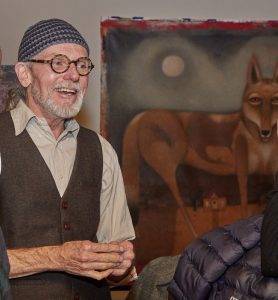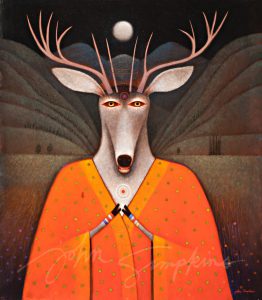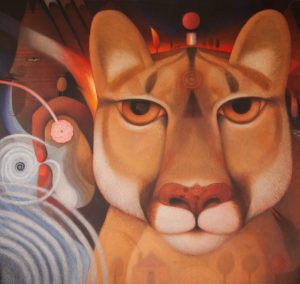 The exhibit Desert Mystic: The Paintings of John Simpkins opened at the High Desert Museum on October 27, 2018. The paintings reflect on the arid landscape and the wildlife surrounding his workspace in a schoolhouse in Andrews, Oregon. The exhibit opening was soon followed by a highly anticipated evening of conversation with Simpkins, filling the Museum’s Schnitzer Entrance Hall with more than 200 visitors eager to hear John discuss his artwork and life. The conversation continues here.
The exhibit Desert Mystic: The Paintings of John Simpkins opened at the High Desert Museum on October 27, 2018. The paintings reflect on the arid landscape and the wildlife surrounding his workspace in a schoolhouse in Andrews, Oregon. The exhibit opening was soon followed by a highly anticipated evening of conversation with Simpkins, filling the Museum’s Schnitzer Entrance Hall with more than 200 visitors eager to hear John discuss his artwork and life. The conversation continues here.
Painting in seclusion in the ghost town of Andrews, Oregon, how do you feel your artwork has evolved in the last seven years, being the town’s only human resident?
Painting is a life process. Living in the ghost town of Andrews, there are few distractions. I have learned to fully trust the intuitive guidance that leads me as I work, and I have released the constraints of time. Paintings evolve as days, weeks and months pass, eventually becoming something that is reflective of my observations, experiences and dreams. I have learned to trust what manifests as I paint. It evolves in each moment.
Some of your canvases are huge, larger than “Blood Moon” (9 feet x 10 feet) at the Museum. Do you find it takes more courage to approach a canvas the larger it is? Do you think it takes any courage to approach any canvas?
I have always been inspired by large canvases exhibited in museums and galleries. When I found myself here at this old one-room schoolhouse I felt it was time to explore this. What would it be like to paint on a canvas that was larger than me? Merriam-Webster defines courage as “mental or moral strength to venture, persevere, and withstand danger, fear, or difficulty.” Perhaps it takes a bit of courage, but mostly it is a marvelous challenge! It becomes much more physical, climbing up and down a ladder to reach the high places or being on my knees to work on the lower parts. It is an adventure! There is no fear, only joy and wonder!

Are there any creatures you’ve had contact with at and around the schoolhouse that you have not been able to paint? If so, what makes that creature different from the mule deer, cougar or badger?
Recently I have observed a group of bluebirds. They seem to be living inside the attic space of the old schoolhouse! They go in and out via a large hole made by a woodpecker and it is winter! There is snow! Yet there are five beautiful bluebirds here! There are magpies, so graphic in their black and white plumage! I may create something to do with this, we shall see. All creatures are marvelous and special to me.
When you spoke to the audience at the High Desert Museum in early November, you mentioned your morning espresso numerous times. It’s clearly an important part of your daily ritual. What kind of espresso do you drink?
It has indeed become a ritual of sorts! I like to sip my espresso from a small bowl, cradling the warmth in my hands. It brings many comforts! I use Organic II Espresso beans from THE BEAN organic coffee company purchased online via Amazon in 5-pound bags and brewed using a small stainless stovetop espresso maker made by Bialetti.
Looking to Steens Mountain every morning and having a front row seat for global climate change as the snow comes later and disappears earlier from the mountain top, are environmental issues taking a more prominent role in your work?
Yes. I am very concerned for our planet and all the precious lifeforms that have evolved here. Living alone with my dog, Ella, each day’s weather becomes the background for my work; I observe the changes and I feel a responsibility to share this in my work.
You document Andrews and the surrounding landscape with some amazing photos shared on Facebook. Have any of the photos inspired paintings? Or do you see your photos and paintings as separate work?
I do think of my photos and my paintings as separate work. It is a delightful challenge to capture the many moods of light and shadow, the weather and seasons of this place with my camera. Most of my photos are taken within the 2-acre parcel of land on which the old Andrews Schoolhouse and Teacherage are situated. My paintings are influenced by what I see and experience here, but I rarely use my photos as the basis for a painting.

How do you know when you’re finished with a painting?
The paintings let me know when they are finished. There is a clear sense that a painting has no further need for me! I may go out to the old schoolhouse ready to begin work, sit and look at the painting and realize that there nothing left to do. It is complete.
Do you see yourself leaving Andrews? After seven years of seclusion, where do you see yourself living and working after this?
I am open to new adventures, though there is no immediate need or desire in me to leave this magical old schoolhouse! I sense there are more stories to tell here. Yet, admittedly there is also a desire in my spirit to perhaps one day return to the southern part of France, to Arles, to find a place to paint and to work there for a month or two.
Find John online at johnsimpkins.com.
